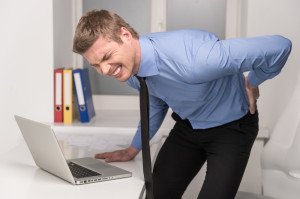- Video Player
Struggling with back pain recently or chronically in Gloucester? Our team of skilled Chiropractors is ready to assist! We specialise in diagnosing the root causes of your pain and devising a plan to restore your well-being.
Repetitive activities not suited for the body can frequently lead to discomfort.
Common daily actions that may result in lower back pain include:
- Sitting at a desk operating a computer
- Long drives in the car
- Heavy lifting
- Digging in the garden
- Poor posture
- Sport
Research by the British Chiropractic Association indicates that around 80% of individuals in Gloucestershire and the South West experience back pain at some point.
The demands of modern work and inactive lifestyles can lead to back pain, joint stiffness, and muscle weakness. It’s essential to maintain a strong and flexible back to avoid becoming susceptible to injuries. Mobilising stiff joints and reinforcing muscle strength is crucial.
For those in Gloucester experiencing lower back pain, routinely applying an ice pack and keeping active are beneficial initial steps. For a comprehensive approach, consult with a Chiropractor at our clinic in Gloucester. We provide thorough assessments, diagnoses, and treatments, equipping you with long-term management strategies to prevent future discomfort.
Back pain is a prevalent and often debilitating condition that can affect individuals of all ages and backgrounds. Whether it’s a sharp, sudden discomfort or a chronic ache, back pain can significantly impact a person’s quality of life. Understanding the various causes of back pain is crucial for effective prevention and management. In this article, we will delve into some of the primary factors contributing to back pain.
- Poor Posture
One of the leading causes of back pain is poor posture. In today’s sedentary lifestyle, many individuals spend prolonged hours sitting at desks or slouching on couches, leading to imbalances in the spine. Over time, this can strain the muscles, ligaments, and discs in the back, causing pain. Maintaining good posture, incorporating ergonomic furniture, and taking breaks to stretch can help alleviate and prevent back pain associated with poor posture. - Muscle Strain and Overuse
Muscle strain often occurs due to overexertion, repetitive movements, or lifting heavy objects improperly. Activities that involve sudden twisting or bending motions can also lead to muscle sprains. When muscles are overused or strained, they can become inflamed and cause pain in the back. Proper body mechanics, regular exercise, and incorporating stretching into daily routines can help reduce the risk of muscle-related back pain. - Herniated Discs
Discs act as cushions between the vertebrae in the spine, providing flexibility and shock absorption. When a disc herniates or ruptures, the inner gel-like material can protrude, putting pressure on surrounding nerves and causing back pain. Aging, genetics, and excessive strain on the spine are common factors contributing to disc herniation. Treatment options range from conservative measures such as physical therapy to more invasive interventions like surgery, depending on the severity of the condition. - Arthritis
Various forms of arthritis, such as osteoarthritis and rheumatoid arthritis, can affect the spine and lead to back pain. Arthritis causes inflammation in the joints, leading to stiffness and discomfort. Degeneration of the spinal joints and the breakdown of cartilage can contribute to chronic back pain. Management typically involves a combination of medications, exercise, and lifestyle modifications. - Structural Abnormalities
Certain structural abnormalities, such as scoliosis or abnormal curvature of the spine, can contribute to back pain. These conditions may be present from birth or develop over time. The altered spine alignment can strain muscles and ligaments, causing pain and discomfort. Treatment may involve physical therapy, bracing, or, in severe cases, surgical intervention. - Psychological Factors
Psychological factors, including stress, anxiety, and depression, can manifest as physical symptoms, including back pain. The mind-body connection is complex, and emotional stressors can contribute to muscle tension and pain. A holistic approach to managing back pain may involve addressing both physical and emotional aspects through techniques like mindfulness, relaxation exercises, and counseling.
Back pain is a multifaceted issue with various potential causes, ranging from lifestyle factors to underlying medical conditions. Identifying the root cause is essential for developing an effective treatment plan. Maintaining a healthy lifestyle, incorporating regular exercise, and being mindful of posture are crucial steps in preventing and managing back pain. If the pain persists or worsens, consulting one of the team here at the Longlevens Chiropractic & Sports Injury Clinic for help to determine the most appropriate course of action for you.
Back pain is a common ailment that can significantly impact one’s daily life, but the good news is that there are various strategies and approaches for treating and alleviating back pain. From lifestyle adjustments to targeted exercises and professional interventions, individuals suffering from back pain can explore a range of options to find relief. In this article, we will discuss some effective methods for treating back pain and improving overall spinal health.
- Physical Activity and Exercise: Regular physical activity is essential for maintaining a healthy spine. Engaging in exercises that strengthen the core muscles, such as the abdominal and lower back muscles, can provide support to the spine and alleviate back pain. Low-impact activities like swimming, walking, and yoga can be particularly beneficial. However, it’s crucial to consult with a healthcare professional or a qualified fitness instructor before starting any exercise program, especially if dealing with chronic back pain.
- Proper Posture: Maintaining good posture is a simple yet effective way to prevent and alleviate back pain. Whether sitting at a desk, standing, or lifting objects, practicing proper body mechanics can reduce strain on the spine. Ergonomic chairs, supportive mattresses, and lumbar support cushions can also contribute to maintaining a healthy posture throughout the day.
- Heat and Cold Therapy: Applying heat or cold to the affected area can help relieve back pain. Heat therapy, such as using a heating pad or taking a warm bath, can relax tense muscles and improve blood flow. Cold therapy, in the form of ice packs, can reduce inflammation and numb the affected area. Alternating between heat and cold treatments can be an effective approach for some individuals.
- Over-the-Counter Medications: Non-prescription pain relievers, such as acetaminophen, ibuprofen, or naproxen, can help reduce pain and inflammation. However, it’s important to use these medications according to the recommended dosage and consult with a healthcare professional, especially if there are underlying health conditions or concerns about potential side effects.
- Chiropractic Care: Chiropractic care, performed by licensed chiropractors, involve manipulating the spine to improve alignment and alleviate pain. Chiropractors apply a hands-on approach and can be hugely effective for back pain relief.
- Mind-Body Techniques: Practices such as yoga, tai chi, and mindfulness meditation can be beneficial for managing and preventing back pain. These techniques focus on the mind-body connection, promoting relaxation, stress reduction, and improved overall well-being.
- Weight Management: Maintaining a healthy weight is crucial for spine health. Excess weight can contribute to back pain by putting additional strain on the spine. Adopting a balanced diet and engaging in regular physical activity can support weight management and reduce the risk of back pain.
Effectively treating back pain often involves a combination of lifestyle adjustments, self-care strategies, and professional interventions. It’s essential for individuals experiencing persistent or severe back pain to consult with healthcare professionals to determine the most appropriate and personalized treatment plan. By adopting a holistic approach that addresses both the physical and emotional aspects of back pain, individuals can enhance their quality of life and promote long-term spinal health. Have a chat with one of the team at Longlevens Chiropractic & Sports Injury Clinic for personalized guidance on helping you get back to normal.
Back pain is a prevalent condition that can significantly impact daily life, but the good news is that many cases can be prevented through proactive measures. Whether you’ve experienced back pain in the past or want to safeguard your spine’s health, adopting preventive strategies is key. In this article, we’ll explore practical and effective ways to prevent back pain and maintain a healthy, pain-free back.
- Maintain a Healthy Weight: Carrying excess weight, especially around the midsection, can strain the back and contribute to pain. Adopting a balanced diet, rich in nutrients, and engaging in regular physical activity can help manage weight and reduce the risk of back pain.
- Exercise Regularly: Regular physical activity is crucial for overall health and plays a significant role in preventing back pain. Focus on exercises that strengthen the core muscles, such as abdominal and lower back muscles. Activities like swimming, walking, and yoga are excellent choices for promoting flexibility and spine health.
- Practice Good Posture: Maintaining proper posture is a fundamental aspect of back pain prevention. Whether sitting at a desk, standing, or lifting objects, be mindful of your posture. Sit with your back straight, shoulders relaxed, and feet flat on the floor. When standing, distribute your weight evenly on both feet, and avoid slouching.
- Ergonomics at Work and Home: Make sure your workspace is ergonomically friendly. Adjust your chair and computer monitor to the correct height to promote good posture. Use supportive chairs and mattresses to provide adequate back support, ensuring that your spine is aligned during sleep.
- Lift Properly: Incorrect lifting techniques can lead to back strain and injury. When lifting heavy objects, bend at the knees, not the waist, and use the strength of your legs to lift. Keep the object close to your body and avoid twisting while lifting.
- Stay Hydrated: Proper hydration is essential for maintaining the elasticity of spinal discs. Dehydration can lead to reduced disc height and increased susceptibility to back pain. Ensure you drink an adequate amount of water throughout the day to support overall spinal health.
- Quit Smoking: Smoking has been linked to an increased risk of back pain. Nicotine restricts blood flow to the discs in the spine, impairing their ability to absorb nutrients and causing degeneration. Quitting smoking can contribute to better spine health.
- Stretch and Stay Flexible: Incorporate regular stretching into your routine to maintain flexibility in the muscles and joints. Stretching helps prevent muscle imbalances and reduces the risk of injury. Focus on exercises that target the back, hamstrings, and hip flexors.
- Manage Stress: Chronic stress can contribute to muscle tension and exacerbate back pain. Incorporate stress-management techniques such as deep breathing, meditation, or yoga into your daily routine to promote relaxation and reduce the impact of stress on your body.
- Regular Health Check-ups: Regular health check-ups can help identify and address any emerging health issues that may contribute to back pain. Consult with healthcare professionals if you experience persistent discomfort or have concerns about your spine health.
Preventing back pain involves adopting a holistic approach that encompasses lifestyle choices, physical activity, and mindfulness. By incorporating these preventive measures into your daily routine, you can significantly reduce the risk of back pain and promote long-term spine health. Remember that individual needs may vary, so it’s advisable to one of the team at the Longlevens Chiropractic & Sports Injury Clinic for personalized guidance on maintaining a healthy and pain-free back.
Accreditations & Affiliations
Chiropractic Organisations



Healthcare Insurance Companies





Acute and Chronic Low Back Pain
Sometimes also referred to as ‘Lumbago’, lower back problems are a particularly common and recurrent problem in many peoples’ lives. Many studies have now shown that with each episode of lower back pain there is a shrinkage in the size of the small deep muscles that support your spine. Once you have had one episode, you can therefore be more likely to have another episode in the future. This can also mean that the longer you have discomfort for, the more vulnerable your back may be.
Lower Back Pain Symptoms
Symptoms commonly experienced with acute and chronic lower back pain include dull, achy, or sharp pain in and around the lower back region. Associated symptoms may be stiffness, sciatica, buttock / leg pain, muscle spasm, swelling, aching, tightness, tingling, numbness, pins and needles and muscle weakness of the lower limbs.
What to do if you have back pain
Lying on your back with your knees flexed (and supported by a cushion) whilst applying an ice pack to the painful area regularly often helps to calm a problem. It is also important to make sure you keep your back moving lightly by walking when possible for short periods around the house for example (see “Why I need to Ice?“).
Treat the pain…
No matter what is causing your back pain, anyone who visits our clinic will always, above all else, receive a full and thorough assessment. Furthermore, we will give you a clear and honest explanation as to what we believe is causing your pain and what the best course of action is to get things back on track.
Our aim is to get you back to your best as quickly as possible using specific mobilisations, gentle manipulation and a wide variety of soft tissue therapies. Dry needling is also used where appropriate. We will also give you a summary of your initial visit so that you have a record to take home.
Prevent recurrence….
Our clinical team pride themselves on preventative care. We will always prescribe a completely personalised ‘home help’ program to ALL patients who visit the clinic. This is essential to make the best and most long lasting recovery. We aim to put you in control, so we can both achieve the most permanent solution possible. Call the clinic today for an appointment on 01452309372 or to chat with a member of the team.
Back Pain During Pregnancy
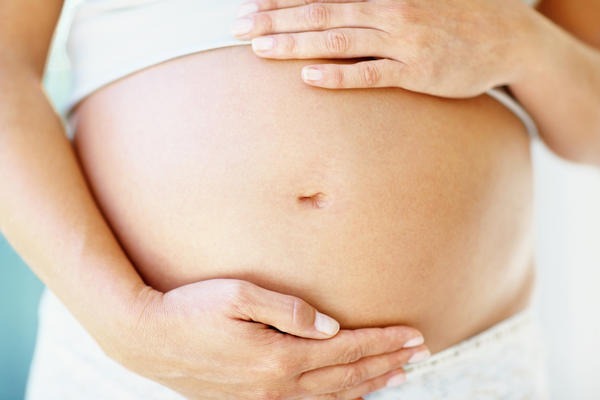 2 out of every 3 pregnant women will suffer lower back and pelvis pain by their 36th week of pregnancy.
2 out of every 3 pregnant women will suffer lower back and pelvis pain by their 36th week of pregnancy.
During pregnancy the changes in hormones (see Relaxin hormone below) can lead to an increase in laxity of the ligaments and cartilage that support the lower back and pelvis. This, coupled with the added weight of carrying a growing baby, can lead to all sorts of ‘strains and sprains’ of the muscles and joints.
As your baby bump grows, the overall weight of your body (and thus your centre of gravity) is increased towards the front. This often causes the pelvis to tilt forwards, pulling muscle beyond its limit and squashing joints together. This increased pressure placed upon the joints of the lower back and pelvis can cause poor movement and inflammation of the joints… leading to low back pain.
After pregnancy the hormones slowly return to normal. The levels of the hormone ‘Relaxin’ that previously gave the joints and ligaments their stretchiness, drops off 5 months after giving birth. This means that the ligaments begin to return to their normal length and position. The first few months after birth can therefore also render the low back vulnerable to injury from new activities such as lifting baby out of a cot or into a car.
Pregnancy and Back Pain Symptoms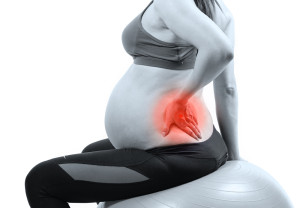
Symptoms of low back pain during pregnancy include discomfort locally, or radiating to and from the lower back and buttocks, instability or ‘clicky’ joints, pubic pain, stiffness, and achey legs. Groin pain and sciatica are also common symptoms.
Applying an ice pack regularly to the back and buttocks, making sure your keep the joint moving, and short walks when possible are just a few simple, basic, and short term strategies to help relieve pain (see “Why I need to Ice?“).
Treat the pain…
No matter what is causing your back pain, anyone who visits our clinic will always, above all else, receive a full and thorough assessment. Furthermore, we will give you a clear and honest explanation as to what we believe is causing your pain and what the best course of action is to get things back on track.
Our aim is to get you back to your best as quickly as possible, using specific mobilisations, gentle manipulation and a wide variety of soft tissue therapies. Dry needling is also used where appropriate. We will also always try to give you a summary of your initial visit so that you have a record to take home.
Prevent Recurrence….
Our clinical team pride themselves on preventative care. We will always prescribe a completely personalised ‘home help’ program to ALL patients who visit the clinic. This is essential to make the best and most long lasting recovery. We aim to put you in control so we can both achieve the most permanent solution possible. Call the clinic today on 01452309372 for an appointment or to chat with a member of the team.
‘Slipped Disc’
‘Slipped disc’ is a layman’s term to describe the squashing of a disc’s core outwards. The disc as a whole does not ‘slip’, more its contents do a little bit like toothpaste being squeezed out of a tube.
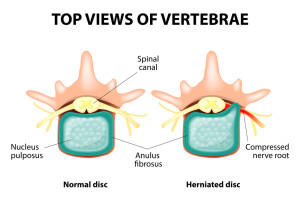 Disc injuries are simple to explain but difficult to recover from if left too long before treatment is sought. The disc in a spine is a large circular ‘lump’ of cartilage (known as the Annulus Fibrosus) with a shock absorbing ‘core’ (known as the Nucleus Pulposus). It sits in between each of the vertebrae and the disc is actually a little bit like a doughnut with a jam core and is designed to be good at shock absorption. However, if you put too much pressure through the disc and squash it beyond its limits, the disc core can push through and herniate into the weakest area of the disc towards the outer edge causing a bulge. A ‘bulging’ disc can be very painful and is often aggravated by prolonged sitting, lifting and long drives.
Disc injuries are simple to explain but difficult to recover from if left too long before treatment is sought. The disc in a spine is a large circular ‘lump’ of cartilage (known as the Annulus Fibrosus) with a shock absorbing ‘core’ (known as the Nucleus Pulposus). It sits in between each of the vertebrae and the disc is actually a little bit like a doughnut with a jam core and is designed to be good at shock absorption. However, if you put too much pressure through the disc and squash it beyond its limits, the disc core can push through and herniate into the weakest area of the disc towards the outer edge causing a bulge. A ‘bulging’ disc can be very painful and is often aggravated by prolonged sitting, lifting and long drives.
The longer the disc remains unstable, the more tricky it can become to get right. If the problem does deteriorate it can impinge the nerves in the spine causing tremendous pain, and sometimes in extreme cases it may require surgery.
Treat the pain…
No matter what is causing your back pain, anyone who visits our clinic will always, above all else, receive a full and thorough assessment. Furthermore, we will give a clear and honest explanation as to what we believe is causing your pain and what the best course action is to get things back on the right track.
Our aim is to get you back to your best as quickly as possible using specific mobilisations, gentle manipulation and a wide variety of soft tissue therapies. Dry needling is also used where appropriate. We will also always try to give you a summary of your initial visit so that you have a record to take home.
Prevent recurrence of pain….
Our clinical team pride themselves on preventative care. We will always prescribe a completely personalised ‘home help’ program to ALL patients who visit the clinic. This is essential to make the best and most long lasting recovery. We aim to put you in control, so we can both achieve a permanent solution where possible. Call the clinic today for an appointment or to chat with a member of the team.
Sciatica
…It can be such a pain in the bum… literally! ‘Sciatica’ is the term used to describe any pain that is originating from irritation of the Sciatic Nerve. This pain can be felt anywhere down a leg, from the bottom to the feet.
The Sciatic Nerve is the longest and thickest nerve in the human body, running from your lower back all the way in to your foot, with its thickest part being around 2cm in width. As you can imagine, a lot can happen to that nerve along its route. The Sciatic Nerve originates as individual spinal nerves known as L4,L5,S1,S2 and S3, these nerves exit the spine individually but then converge to create the Sciatic Nerve.
Disc Bulges
The most common cause of Sciatica is what is known as a Disc Bulge. A disc bulge between the vertebrae of L4 and L5 or between the vertebrae of L5 and S1 can lead to ‘Sciatica’.
A disc bulge essentially only affects the nerve at the level at which the bulge is occurring. For example, a backwards and to the side (postero-lateral) Disc Bulge at L5/S1 usually causes pain/tingling/numbness/pins and needles at the sole and outside edge of the foot on the same side as the bulge. This is because the nerve exiting between the spinal segments of L5 and S1 is what is known as the S1 nerve root. The S1 nerve supplies both muscles (a Myotome) and skin sensation (a Dermatome). So as you can see the S1 nerve supplies sensation to the sole and outer edge of the foot which is why pain is felt here.
This applies to all nerves exiting the spine. If one level has a bulge then the skin it supplies may have a change in sensation. The muscles that each affected nerve innervates may also not work correctly or may even begin to decrease in size and become flaccid.
Foraminal Stenosis
The word ‘Foramen’ basically means ‘a hole’, where the L4, L5, S1, S2, S3 nerves leave the spine between each vertebral segment is a hole called the ‘Intervertebral Foramen’. If anything decreases space at this Foramen then Sciatica can occur, problems such as bony spurs, inflammation, a Spondylolisthesis or a Tumor can all cause a decrease in space here and irritate the nerve as it exits. This can therefore be one of the causes that lead to irritation of the Sciatic nerve and the symptoms associated to it.
Piriformis Syndrome
In a nutshell ‘Piriformis Syndrome’ occurs as a result of the Sciatic nerve being irritated by the Piriformis Muscle.
The Sciatic nerve’s relationship with the Piriformis Muscle differs from person to person. Most commonly it passes beneath the Piriformis Muscle, however for some, it can actually pass through the Piriformis Muscle entirely, or even stay split around it and connect after.
The Piriformis is an external rotator of the the leg. If it gets too tight (common in a lot of people) it can become irritated, this leads to inflammation at the muscle and surrounding tissues, which in some cases includes the Sciatic Nerve.
Treat the pain…
No matter what is causing your back pain, anyone who visits our clinic will always, above all else, receive a full and thorough assessment. Furthermore, we will give you a clear and honest explanation as to what we believe is causing your pain and what the best course of action is to get things back on track.
Our aim is to get you back to your best as quickly as possible, using specific mobilisations, gentle manipulation and a wide variety of soft tissue therapies. Dry needling is also used where appropriate. We will also give you a summary of your initial visit so that you have a record to take home.
Prevent recurrence of pain….
Our clinical team pride themselves on preventative care. We will always prescribe a completely personalised ‘home help’ program to ALL patients who visit the clinic. This is essential to make the best and most long lasting recovery. We aim to put you in control, so we can both achieve the most permanent solution possible. Call the clinic today for an appointment on 01452309372 or to chat with a member of the team.

The Royal College of Chiropractors Clinical Management Quality Mark

Managing the Clinical Environment
The Royal College of Chiropractors Patient Partnership Quality Mark

Meeting Patient Expectations

